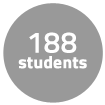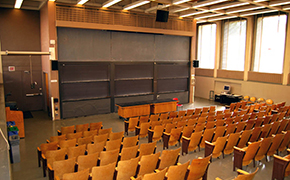Instructor Insights pages are part of the OCW Educator initiative, which seeks to enhance the value of OCW for educators.
Course Overview
This page focuses on the course 7.016 Introductory Biology as it was taught by Prof. Barbara Imperiali, Prof. Angelika B. Amon, and Dr. Diviya Sinha in Fall 2014.
This course provided an introduction to fundamental principles of biochemistry, molecular biology and genetics for understanding the functions of living systems. Taught for the first time in Fall 2013, 7.016 covered examples of the use of chemical biology and twenty-first-century molecular genetics in understanding human health and therapeutic intervention. Learn more here:
Xu, K. "Life explained differently: two new intro biology classes," The Tech, October 18, 2013.
Delmore, A. "The new faces of the GIRs: makeovers in biology, chemistry," The Tech, January 31, 2014.
Gill, S. "Biology department creates 6-7 MEng with EECS, new GIR classes," The Tech, April 19, 2013.
Lao, C. "ASE pass rates up for most GIRs, especially biology," The Tech, October 21, 2014.
Course Outcomes
Course Goals for Students
- Gain an understanding of biochemistry genetics, molecular biology, recombinant DNA technology, and cell biology
- Examine these topics through the lens of chemistry
Possibilities for Further Study/Careers
- 7.016 is a Biology GIR
 and a prerequisite for many classes in the biology department.
and a prerequisite for many classes in the biology department. - Students who successfully complete 7.016 are also eligible to take 9.12 Experimental Molecular Neurobiology and 2.797J/6.024J Molecular, Cellular, and Tissue Biomechanics.
I’ve also found that offering one-on-one tutoring helps me get to know students and understand the material with which they are struggling.
—Dr. Diviya Sinha
Below, Dr. Diviya Sinha describes assessment in 7.016 Introductory Biology.
Assessment in large lecture classes can be challenging because professors have limited opportunities to interact one-on-one with students. One way we assess students’ learning during lectures is by using clicker questions. If, through their responses, students indicate that they do not understand fundamental concepts, we address these concepts immediately in the lecture.
In addition to using clicker questions, we also get regular feedback from teaching assistants, who work closely with the students twice a week. Collective feedback from all of the teaching assistants gives us a good indication of how the class, as a whole, is doing with the material. I’ve also found that offering one-on-one tutoring helps me get to know students and understand the material with which they are struggling.
Of course, we also assess students’ learning via exams. In creating exams for the course, it’s very important to ensure that the content of the exams is a fair representation of the material introduced in the lectures and practiced by students in the recitations and through problem sets. It’s also important that questions are written at a certain level of difficulty so that we can distinguish students who are completing A-level work from students completing B-level work.
After I complete a first draft of an exam, it goes through four or five rounds of editing. Each round involves one or two teaching assistants, who not only provide comments regarding whether or not concepts are over or underemphasized on the assessment, but also take the exam. If the exam is a 50-minute exam, I make sure the teaching assistants are able to complete it in 20 or 25 minutes. Only then can we expect students to complete it within 50 minutes. Once the final draft is almost complete, I send it to the professors to review and they provide me with comments. It’s important that everyone on the teaching team be involved so that the exam can be as fair and as challenging as possible.
Curriculum Information
Prerequisites
None.
Requirements Satisfied
- Biology GIR
- This course can be applied toward a Bachelor of Science in Biology.
Offered
Every fall semester
Assessment
The students' grades were based on the following activities:
 45% Term Exams (100 points each, 300 points total)
45% Term Exams (100 points each, 300 points total) 20% Problem Sets (20 points each, 120 points total)
20% Problem Sets (20 points each, 120 points total) 35% Comprehensive Final (200 points total)
35% Comprehensive Final (200 points total)Read insights from Dr. Diviya Sinha about assessment.
Student Information

Breakdown by Year
Mostly freshmen.
Typical Student Background
Typically, some students who enroll in the course already have a strong interest in biology and chemistry and are able to explain the material well; occasionally, these students become tutors or graders after they complete the course.
During an average week, students were expected to spend 12 hours on the course, roughly divided as follows:
Lectures
- Met 3 times per week for 1 hour per session; mandatory attendance.
- Lectures included the use of clicker questions
 .
.
Recitation
- Met 2 times per week for 1 hour per session; attendance was expected.
- Teaching assistants supported students as they worked on problem set questions.
Out of Class
- Students completed readings, problem sets, and prepared for exams.
- Attended optional office hours and tutoring sessions.
Semester Breakdown
| WEEK | M | T | W | Th | F |
|---|---|---|---|---|---|
| 1 |  |  |  |  |  |
| 2 |  |  |  |  |  |
| 3 |  |  |  |  |  |
| 4 |  |  |  |  |  |
| 5 |  |  |  |  |  |
| 6 |  |  |  |  |  |
| 7 |  |  |  |  |  |
| 8 |  |  |  |  |  |
| 9 |  |  |  |  |  |
| 10 |  |  |  |  |  |
| 11 |  |  |  |  |  |
| 12 |  |  |  |  |  |
| 13 |  |  |  |  |  |
| 14 |  |  |  |  |  |
| 15 |  |  |  |  |  |
| 16 |  |  |  |  |  |
 No classes throughout MIT
No classes throughout MIT Lecture session
Lecture session Assignment due date
Assignment due date No class session scheduled
No class session scheduled Recitation session
Recitation session Exam
Exam

 Room 1 of 1
Room 1 of 1 